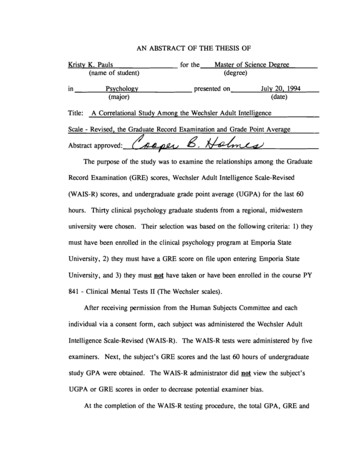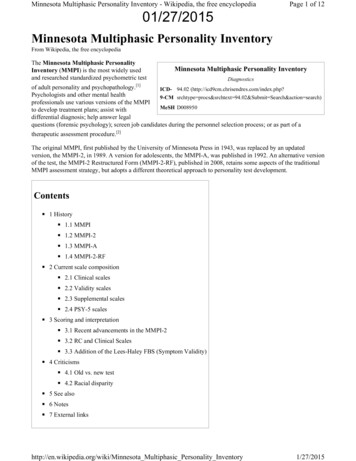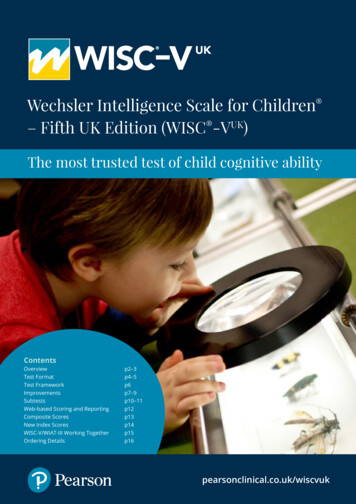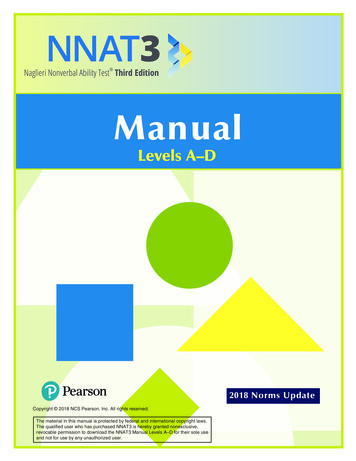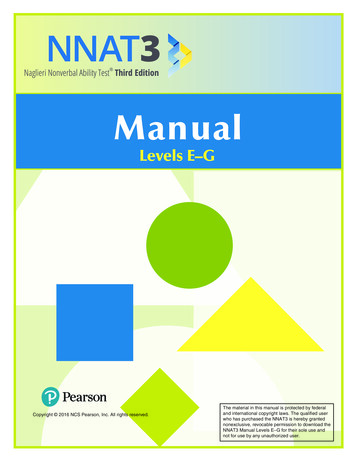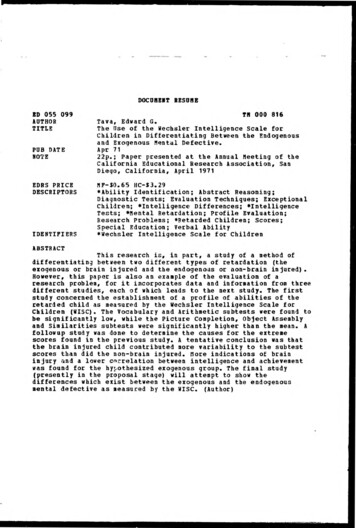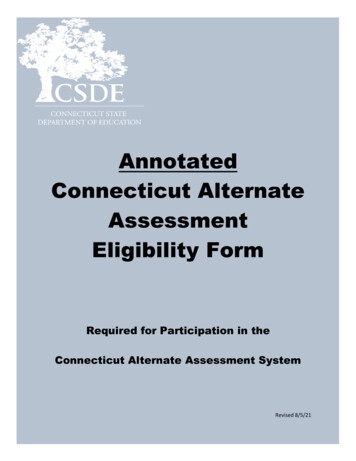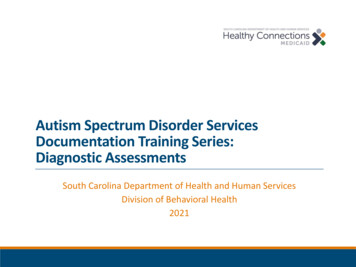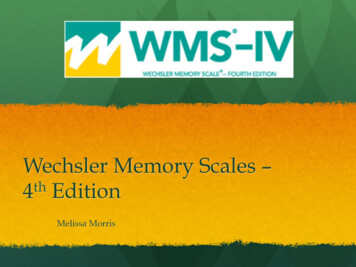
Transcription
Wechsler Memory Scales –th4 EditionMelissa Morris
Theory Based on theory that memory and learning areclosely linked. Learning – process of acquiring new information Memory – the persistence of learning in a state thatcan be revealed at a later time Memory is the indicator that learning has occurred WMS-IV measures the ability to learn andremember information that is presented verballyand visually.
Process of Learning andRememberingENCODINGExternal information is transformed intomental representations or memories.CONSOLIDATIONBiological process that solidify informationfrom immediate memory into long-termmemory.RETRIEVALBringing stored information into consciousawareness, or remembering.
Development of Test Revision of the WMS-III Added items include a brief evaluation of cognitivestatus Revised to include two batteries: An adult battery (ages 16-69) Older Adult battery (ages 65-90) Shorter Developed to decrease testing time, reduce examinee fatigue,and improve the psychometric functioning of the subtests inolder adults No manipulatives are required for the older battery, thusincreasing kit portability Examinees ages 65-69 may be administered either battery
Development of Test Found that memory performance declined duringlong testing sessions – WMS-IV reduced test time Wanted to make sure that the WAIS-IV and WMS-IVdidn’t test memory in the same way – removedDigit Span and Letter-Number Sequencing Subtests WMS-IV : Focuses on components of visual workingmemory WAIS-IV : focuses on auditory working memory
Development of Test Included a Brief Cognitive Status Exam, designed toidentify significant cognitive difficulties that mayindicate dementia or other cognitive impairment. Conducted three pilots and a tryout phase beforeStandardization
Standardization Co-normed with the WAIS-IV, but WMS-IVcontinued data collection beyond the WAIS 1400 examinees included 900 completed Adult Battery 500 completed Older Adult Battery Equal number of male and female examinees in eachage group Older age group contained more females than males
Standardization Race/Ethnicity Based on 2005 Census Education Level Stratified according to 5 education levels (0-8 yrs, 9-11yrs, 12 yrs, 13-15 yrs, 16 or more yrs)
Sampling Sites
DemographicCharacteristics
ReliabilityInternal Consistency Reliability Calculated using split-half and alpha methods Stability coefficients were used on subtests for which InternalConsistencies were not appropriateIndexAverage r(Ages 16-69)Average r(Ages 65-90)Auditory Memory.95.95Visual Memory.96.97Visual Working Memory.93Immediate Memory.95.95Delayed Memory.94.92Test-Retest Reliability Adult Battery Indexes: .77-.95 (VWMI .29) Older Adult Battery Indexes: .69-.88
Content Validity Ensure that the items included in the WMS-IVadequately sample the domains of memoryfunctioning Comprehensive literature and expert reviews wereused to evaluate content validity Using an expert panel, modifications were made ifnecessary
Construct ValidityUsing Factor-Analytic Studies Model 1 Visual memory, Auditory Memory Model 2 Visual Memory, Visual Working Memory,Auditory Memory Adjusted Goodness of Fit Index (AGFI) : should begreater than .90 or .95 Root Mean Squared Error of Approximation (RMSEA) : .05 or less is a close model fit and up to .08 representadequate model fit with reasonable errors Tucker-Lewis nonnormed fit index (TLI) : Two-factormodel returns slightly better TLI values than Threefactor model
Construct Validity
Concurrent Validity Examines the relationship between the WMS-IV testscores and other measures. WMS-IV Indexes to WISC-IV FSIQ .49-.68 WMS-IV Indexes to WAIS-III FSIQ .58-.67
Test Kit
Test StructureFive Index Scores:Seven Subtests: Auditory Memory (AMI) Logical Memory Visual Memory (VMI) Verbal Paired Associates Visual Working Memory(VWMI) Designs Visual Reproduction Spatial Addition Symbol Span Immediate Memory (IMI)Delayed Memory (DMI)Also included is a Brief CognitiveStatus Exam
Test Structure Auditory Memory (AMI) ability to remember orallypresented information Visual Memory (VMI) ability to remember visuallypresented information Visual Working Memory (VWMI) capacity to rememberand manipulate visually-presented information in short-termmemory storage Immediate Memory (IMI) ability to remember bothvisually- and orally-presented information immediately afterit is presented Delayed Memory (DMI) ability to remember both visuallyand orally-presented information after a 20-30 minute delay.
Types of Scores Primary Subtest Scaled Scores(mean 10, sd 3; range 1-19) Index Scores(mean 100, sd 15; range 40-160) Process Scores Contrast Scaled Scores Answers hypothesis about an examinee’s performancerelative to his/her performance on other measures.
Diagnostic Use Alzheimer’s Disease ADHD Mild Cognitive Impairment Reading Disorder Major Depression Mathematics Disorder Traumatic Brain Injury Autism Right and Left TemporalLobectomy Intellectual Disability SchizophreniaWith any Memory Concerns!J
LiteratureReviewWhen compared to the WMS-IIIsingle factor solution, Hoelzle(2011) found that the WMS-IVfactor structure ismultidimensional and reflectsimportant auditory and visualmemory. Findings show that the“WMS-IV is an improved, usefulinstrument to evaluate auditoryand visual memory” (Hoelzle,2011).Carlozzi, Grech, Tulsky (2013)describes the WMS-IV as “a validtool for evaluating memoryfunctioning in individuals withTBI” (p. 913).Miller, Davison, Schindler, andMessier (2011) published astudy evaluating the factoranalysis of the WAIS-IV andWMS-IV. Although they foundtheir scaled scores for subtestswere relatively close to thepublished norms, theydiscussed the “need for new,independent samples to becollected and comparedagainst the normativeone” (Miller et all., 2013).
Personal Review &Impression Short and easy to administer All instructions in stimulus books WMS-IV evaluates memory within different contexts (visual, auditory,etc.) Uses Wechsler format that we are all familiar with, including Start Points,Discontinues and Reversal Rules Must be familiar with administration, as unfamiliarity and unclearinstructions could affect how well the examinee remembers and is able toperform task Designs subtest uses a lot of cards, but it is easy to administer if you keepthe design cards organized. Spatial addition is the most difficult subtest to administer
Subtest Descriptions
Brief Cognitive StatusExamThis optional subtest assesses a variety of cognitivefunctions. The examinee performs simple tasks in a numberof different areas including: Orientation to time, Mental control, Clock drawing, Incidental recall, Automatically and inhibitory control, and Verbal production.
Logical Memory Assesses narrative memory Logical Memory I Two short stories are presented orally For older adults, one story is presented twice The examinee is asked to retell each story frommemory immediately after hearing it. Logical Memory II Examinee is asked to retell both stories Asked yes/no questions about both stories
Verbal Paired Associates Assesses verbal memory for associated word pairs. Verbal Paired Associates I Examiner reads 10 or 14 word pairs Then examiner reads first word of each pair, and asksexaminee to provide the corresponding word Verbal Paired Associates II Examiner provides first word and examinee providescorresponding word Examinee is read a list of word pairs and asked to identifyif the word pair is one they already heard or a new wordpair. During the optional word recall task, examinee is asked tosay as many of the words from the pairs as he or she canrecall.
Visual ReproductionAssesses memory for nonverbal visual stimuliScoring Templates are used for scoring. Visual Reproduction I A series of 5 designs is shown, one at a time, for 10 seconds each After each design is presented, the examinee is asked to draw thedesign from memory. Visual Reproduction II First, examinee is asked to draw designs, from memory, in VisualReproduction I Second, examinee examinee is asked to choose which of sixdesigns on a page match the original design Third, for an optional copy task, the examinee is asked to drawdesigns while looking at them.
DesignsAssesses spatial memory for unfamiliar visual material Designs 1 Examiner shows examinee a grid with 4-8 designs onapage for 10 seconds, then removes the page from examinerview. Examinee then selects the design from a set of cards andplaces the cards in a grid in the same place as shown. Designs 2 Examinee is asked to recreate the pages shown earlier withthe cards and grid. Then he or she is shown a series of grids and asked to selectthe two designs that are correct and in the same place as onthe pages shown in Design 1
Spatial Addition (ages 16-69)Assesses visual-spatial working memory using avisual addition task. Examiner shows examinee, sequentially, two gridswith blue and red circles. Then examinee is asked to add or subtract thelocation of the circles based on a set of rules.
Symbol SpanAssesses visual working memory using novel visualstimuli. Examinee is briefly shown a series of abstractsymbols on a page and then asked to select thesymbols in an array of symbols, in the same orderthat they were presented on the previous page.
ReferencesCarlozzi, N., Grech, J., & Tulsky, D. (n.d). Memory functioning in individuals with traumatic braininjury: An examination of the Wechsler Memory Scale-Fourth Edition (WMS-IV). Journal OfClinical And Experimental Neuropsychology, 35(9), 906-914.Hoelzle, J. A. (2011). Comparison of Wechsler Memory Scale-Fourth Edition (WMS-IV) and ThirdEdition (WMS-III) dimensional structures: Improved ability to evaluate auditory and visualconstructs. Journal Of Clinical & Experimental Neuropsychology, 33(3), 283-291.Maccow, G. (2011). WMS-IV: Administration, Scoring, Basic Interpretation. Pearson Clinical. Retrievedfrom WMS-IV/WMSIV Webinar September 2011 Handout.pdfMiller, D. I., Davidson, P. R., Schindler, D., & Messier, C. (2013). Confirmatory Factor Analysis of theWAIS-IV and WMS-IV in Older Adults. Journal Of Psychoeducational Assessment, 31(4), 375-390.Wechsler, D (2009). Wechsler Memory Scales – Fourth Edition (WMS-IV): Administration and ScoringManual. San Antonio, Texas: Pearson Clinical Assessment.Wechsler, D (2009). Wechsler Memory Scales – Fourth Edition (WMS-IV): Technical and InterpretiveManual. San Antonio, Texas: Pearson Clinical Assessment.
injury: An examination of the Wechsler Memory Scale-Fourth Edition (WMS-IV). Journal Of Clinical And Experimental Neuropsychology, 35(9), 906-914. Hoelzle, J. A. (2011). Comparison of Wechsler Memory Scale-Fourth Edition (WMS-IV) and Third Edition (WMS-III) dimensional structures: Improved abi


